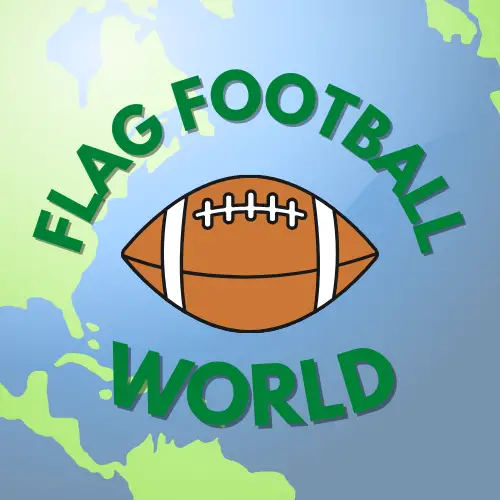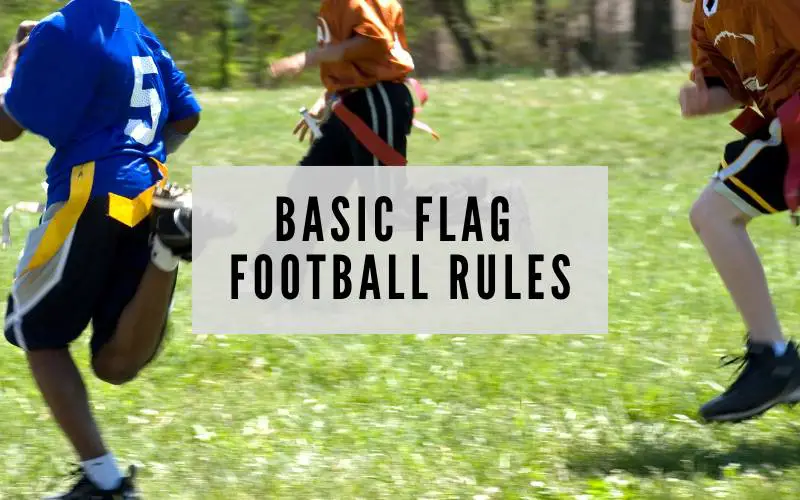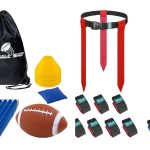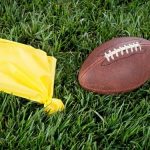People of all ages can enjoy the fun and excitement of flag football. But, no matter if you’re a seasoned pro or a new player, it’s crucial to understand the fundamental guidelines of the game.
In flag football, which is a variation of American football played without using helmets and pads, participants wear flags around their waists. Due to this adjustment, it is a safer and more accessible sport for those who may not be used to football’s brutality.
This article offers a thorough explanation of flag football’s fundamental rules, including everything from the field size and equipment to the scoring system and penalties. By the end, you will have all the information you need to get started, whether you want to play with friends and family or join a local league.
Summary of Flag Football Rules
First, a quick rundown of flag football basics before we dive into greater detail:
- Field size: The field is usually 30-40 yards wide and 70-80 yards long.
- Team size: Each team typically has 5-7 players on the field at a time.
- Object of the game: Score more points than the other team. Points can be scored by carrying the ball across the opposing team’s goal line, or by catching a pass in the end zone.
- Defending: The defending team tries to stop the other team from advancing the ball by pulling the flags attached to the ball carrier’s waist. Once a flag is pulled, the ball carrier is considered “down” and the play is over.
- First downs: Like in traditional football, a team must advance the ball a certain distance to earn a first down and continue their drive.
- Scoring: Touchdowns are worth 6 points, and after a touchdown, the scoring team can attempt a conversion by running or passing the ball into the end zone for an additional 1 or 2 points.
- Time limit: Games typically consist of two 20-25 minute halves, with a 5-10 minute halftime.
- Penalties: Penalties can be called for various reasons, such as offsides, holding, or pass interference, and may result in the loss of yardage or loss of possession.
It’s important to note that specific leagues and organizations may have variations on these rules, so be sure to check with your league or coach for any additional guidelines or modifications.
Playing the Game
The game begins with a coin toss to determine which team will have the first possession.
The offensive team takes possession of the ball on their own 5-yard line and has three plays to cross midfield or gain sufficient yardage for a first down. Once a team crosses midfield, they have three plays to score a touchdown. If they fail to score, possession of the ball changes.
All possession changes, except for interceptions, start on the offense’s 5-yard line. Some variations of flag football allow punts while others don’t.
If the defensive team scores a safety, they take possession at midfield.
Positions on the Field
The player positions on offense usually are:
- Quarterback
- Center
- Running back
- Wide receivers
For games with more players on the field, linemen and tight ends may be added to the mix.
The players on defense are usually:
- Pass rushers
- Linebackers
- Cornerbacks
- Safeties
Starting the Game
The game begins with a coin toss. The team that wins the coin toss can choose which goal it would like to defend, or it can elect to receive the ball to start the game or second half. The team that loses the coin toss will have the opposite in the second half.
The team that is on offense will then take their place behind the 5-yard line, and the team on defense will take their place opposite of them. Play begins when the center snaps the ball to the quarterback.
Game Timing
Games consist of 20-25 minute halves or four 10-minute quarters, with a 5-to-10-minute halftime break. If the scores are equal at the end of regulation play, then there will be an extra 3-5 minutes are played. The team that scores first in overtime wins the game.
The clock runs continuously except for a change of possession, a touchdown and point after attempt, injury, or timeout. It also stops in the last two minutes of halves when the ball carrier runs out of bounds and on incomplete passes.
Scoring Points
The rules for scoring in flag football are pretty simple. A touchdown is worth 6 points, and a successful extra point kick (from the 3-yard line) is worth one point.
If the offense elects to go for 2 points, then they will line up on the 10-yard line. A safety is worth 2 points and is awarded to the defense when an offensive player is down with the ball in his own end zone.
It’s important to note that the focus is on having fun and developing skills. For young players under the age of 8 just starting out, keeping the score is not necessary or suggested.
Scoring a Touchdown
A touchdown is scored when a player crosses the opposing team’s goal line with the ball in their possession. A player can also score a touchdown by catching a pass in the end zone or by returning a punt or interception.
Scoring Extra Points
The scoring team may attempt to score an extra point after a touchdown by kicking the ball through the uprights (if the field has them). A successful kick is worth one point.
Alternatively, the scoring team can try to get into the end zone from the 3-yard line for 1 point. If the offense elects to go for two points, then they will line up on the 10-yard line.
Scoring a Safety
The defensive team is awarded two points when an offensive player is tackled with the ball in his own end zone. When this happens, the team that recorded the safety also takes possession of the ball on offense.
Penalties & Fouls
Unlike other sports, flag football has very few penalties. This is because the sport is meant to be non-contact and safe. However, there are some penalties that can be called.
The most important and primary rule is that players are not allowed to contact each other in any way. This includes tackling, blocking, or any form of physical contact. Doing so will result in a personal foul, and the player will be ejected from the game.
Other penalties and fouls are explained below. Five and 10-yard penalties are the most common types called by referees.
Personal Fouls
No player should ever physically contact another player. This includes tackling, blocking, stiff-arming, or any other form of physical contact. Doing so will result in a personal foul. Additionally, the player may get ejected from the game.
A personal foul can also be called if a player uses language or gestures considered offensive, if a player is taunting another player or an official, or if a player is engaging in any other unsportsmanlike conduct. This includes cheap shots and offensive language.
Offensive Penalties
Some of the common penalties that may arise are:
Offensive holding/ Illegal block: If a player on the offense team illegally blocks a defensive player.
Quarterback crossing during pass: If the quarterback crosses the line of scrimmage and passes the ball.
Offensive pass interference: If the offensive team interferes with the defense team’s ability to catch the ball.
Flag guarding: If a player on the offense team protects their flag by using their body, or any other object.
Illegal procedure: If the offensive team commits a procedural error, such as an illegal snap or an ineligible receiver downfield.
Delay of game: If the offense team delays the game, such as by taking too long to snap the ball.
Impeding the rusher: If the offense team impedes the defensive player’s ability to rush the quarterback.
Illegal motion: If an offensive player is in motion before the snap.
Defensive Penalties
Some of the common penalties that may arise are:
Pass interference: If the defense team interferes with the offense team’s ability to catch the ball.
Roughing the passer: If the defense team hits the quarterback after throwing the ball.
Unnecessary roughness: If the defense team uses excessive force against a player.
Defensive holding: If a player on the defense team illegally holds onto an offensive player to stop them from getting open to remove their flag.
Defensive offsides: A penalty will be given to the defense if any player crosses the line of scrimmage before the snap.
Illegal flag pull: If the defense team pulls the flag of an offensive player who does not have the ball.
Rules for the Offense
Passing
All passes must be thrown forward and received beyond the line of scrimmage. Shovel passes are allowed, but they must also be received beyond the line of scrimmage.
The quarterback is given a seven-second “pass clock” to throw the ball after the snap. If the pass is not thrown within seven seconds, the play is dead and results in a loss of down. Once the ball is handed off, the seven-second rule no longer applies.
If a pass is intercepted, the opposing team takes possession of the ball at the point of interception. This is the only change of possession that does not start on the 5-yard line.
Running
The quarterback is not allowed to run with the ball at any point during the game. Additionally, only direct handoffs behind the line of scrimmage are permitted, and the offense may use multiple handoffs. However, there can be absolutely no laterals or pitches of any kind.
“No-running zones” are located 5 yards from each end zone and 5 yards on either side of midfield, designed to avoid short-yardage, power-running situations.
When a player takes the handoff, they are allowed to throw the ball from behind the line of scrimmage. Once the ball has been handed off, all defensive players are eligible to rush.
While spinning is allowed, players cannot leave their feet or dive to avoid a defensive player. A runner also cannot stiff arm or plow through a defender to avoid having their flag pulled.
It’s important to note that the ball is spotted where the ball carrier’s feet are when the flag is pulled, not where the ball is.
Receiving
All players, including the quarterback, are allowed to receive passes. When making a reception, the player must have at least one foot in bounds.
A player who catches a pass can advance the ball until their flag is pulled or they run out of bounds.
Rules for the Defense
Stopping a Ball Carrier
The defense aims to stop the ball carrier by pulling one or both of the flags attached to the ball carrier’s waist. Once a flag is pulled, the ball carrier is considered “down,” and the play is over.
Defenders must time their flag pulls correctly to avoid penalties such as holding or grabbing. They should wait until they are within arm’s reach and then make the pull quickly.
Defensive players should not make contact with a ball carrier. Tackling, pushing, and holding is not allowed.
Defending Passes
A player can defend a pass by preventing the receiver from catching the ball or by intercepting the ball themselves. It’s important for the defender to avoid making contact with the receiver before the ball arrives, as this can result in a penalty for pass interference.
Rushing the QB
In many flag football leagues, a rush marker is placed seven yards from the line of scrimmage. Any number of players may rush the quarterback as long as they are behind the rush marker when the ball is snapped.
If the offense draws a rusher to jump inside the seven-yard marker prior to the snap of the ball, that rusher cannot rush during that play. However, any other defender that is seven yards back may rush instead.
The rusher must take an angled path to the quarterback. If this path is crossed and contact is made involving the rusher and any offensive player, an offensive impeding penalty will be assessed.
Once the rusher’s path is set, he/she cannot change their path to the QB. If the path is changed, they will lose right-of-way privileges.
The rusher cannot run straight into the center. The center has the right of way, so long as the center remains in his/her original spot at the time the ball was snapped. If contact is made with the center by the rusher who has not taken an angle to the quarterback, a defensive impeding penalty will be assessed.
Players not rushing the quarterback may defend the line of scrimmage. The rusher may attempt to block the pass, but it is a penalty to make contact with the quarterback’s arm.
Punting
To punt on 4th down, the offensive team can choose to do so from a protected scrimmage. During the punt, the defense is not allowed to cross the line of scrimmage, and they can only try to block the punt by jumping straight up in the air on their side of the ball.
On the punting team, all players except the punter must be on the line of scrimmage and cannot move until the ball is kicked. If the punt crosses the scrimmage line and touches a player from either team and then hits the ground, possession of the ball goes to the receiving team.
Turnovers
The opposing team gains possession of the ball when its defense recovers a fumble from a ball carrier or catches an interception on a quarterback pass. A fumble can also be recovered by the offense.
Interceptions can be advanced down the field by a defensive player after they gain possession. They are only stopped when they run out of bounds, one of their knees touches the ground, or their flag is pulled by an opponent. A fumble cannot be returned and play stops immediately on a recovery.
The ball is also turned over when an offense fails to gain a first down after four tries.
Ties and Overtime
The game will go into overtime if it is tied at the end of regulation time. During overtime, both teams get a chance to score from the opponent’s 25-yard line. If, after one period of overtime, there is still no winner, then a second overtime period begins. This pattern continues until there is finally a victor.
Rules for Substitutions
Before each play, both teams are allowed to substitute players. A team that has too many players on the field at a given time will be penalized.
If a team has fewer players on the field than what is allowed when the ball is snapped, they will not be able to substitute any players until the play is over. A team that substitutes players illegally will result in a penalty.
Equipment & Attire
The equipment and attire required for flag football are pretty much the same as what you would need for any other sport. Players will need a good pair of cleats (tennis shoes or rubber cleats are allowed, but metal cleats are not), a mouthguard, and a flag belt with flags attached.
In addition, all players must wear a uniform and flag that the association provides during play.
Some players may choose to wear extra padding, such as soft shell helmets, a jock strap, and knee and elbow pads to prevent scrapes and bruises.
Clothing that may obstruct members of the other team or cover the flags is not allowed. This includes shorts with pockets and long shirts.
It is advised not to wear baseball caps, jewelry, or other accessories that may harm yourself or others playing.
Play Flag Football With Your Friends!
Flag football is really an easy game to learn and play. So get some friends, choose sides, and have a great time!
You can start playing flag football informally with just a few friends. But if you want to join or start a team, there are flag football leagues all across the country for players of all ages and skill levels.
You already understand the rules of flag football. So go out and play!

Vance J has played flag football since he was a boy. Since then, he has become a coach and a huge advocate for growing the sport. He loves to write and talk about flag football!







